ICSE Solutions for Class 7 History and Civics – The Delhi Sultanate
ICSE SolutionsSelina ICSE SolutionsML Aggarwal Solutions
APlusTopper.com provides step by step solutions for ICSE Solutions for Class 7 History and Civics. You can download the History and Civics ICSE Solutions for Class 7 with Free PDF download option. History and Civics for Class 7 ICSE Solutions all questions are solved and explained by expert teachers as per ICSE board guidelines.
ICSE Solutions Class 7 History & CivicsGeographyMathsPhysicsChemistryBiology
Important Words
- Price control is the practice where the king or the government controls the prices of goods to prevent shopkeepers from increasing prices.
- Devagiri was the city which Muhammad bin Tughlaq chose to shift his capital to. He renamed it Daulatabad.
- Token currency was the system of currency introduced by Muhammad bin Tughlaq where brass and copper coins were to have the same value as silver and gold coins.
- The ulema were the group of Muslim religious scholars who also advised the king.
Time To Learn
I. Fill in the blanks:
- Qutab-ud-din Aibak was the real founder of the Slave Dynasty.
- Razia was nominated by Iltutmish as his successor.
- Balban’s theory of kingship was divine.
- Jalal-ud-din Khalji was the first Khalji ruler.
- Malik Kafur led many campaigns in North India and every time he brought a huge booty of gold, jewels, elephants and horses.
- Amir Khusrau was a well-known poet in the court of Ala- ud-din Khalji.
- Ala-ud-din constructed a big tank called Hauz khas.
- Muhammad-bin-Tughlaq shifted his capital from Delhi to Devagiri.
- Amir Timur invaded India in AD 1398.
- Muhammad-bin-Tughlaq introduced copper coins in place of gold and silver coins.
II. Match Column A with Column B:
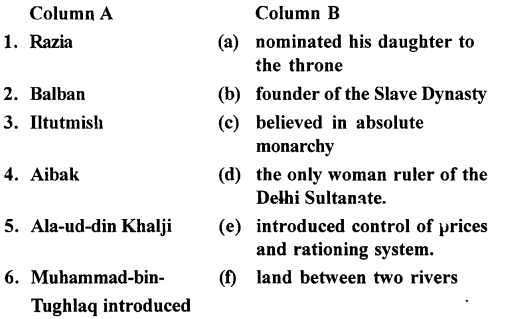

Answer:
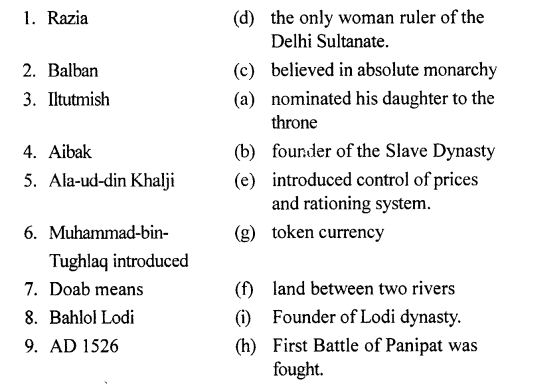
III. State weather the following statements are True Or False:
- Qutub-ud-din Aibak built the Qutab Minar of Delhi.
True - Balban believed in absolute monarchy.
True. - Malik Kafur was also known as Hazar Dinari because he was bought for a thousand dinars.
True. - Muhammad-bin-Tughlaq is known as a ‘mixture of opposites’.
True. - Firoz Shah Tughlaq was Muhammad-bin-Tughlaq’s son.
False.Firoz Shah Tughlaq was Muhammad-bin-Tughlaq’s cousin. - Sikandar Lodi lost control over the Gangetic Valley.
False Ibrahim Lodi lost control over the Gangetic Valley. - Khizr Khan was the founder of Sayyid dynasty.
False. Khizr Khan was the deputy of Sayyid dynasty.
IV. Answer the following questions briefly:
Question 1.
What were the difficulties that Iltutmish had to face and how did he tackle them?
Answer:
Iltutmish position was challenged from the very beginning since he had no hereditary claim over the throne. But Iltutmish proved himself as a strong and efficient ruler.
Question 2.
Write in brief about the rise and fall of Razia Sultan.
Answer:
Razia was brave, intelligent, and possessed all the royal qualities. She dressed like a man and used to sit in the open darbar to transact business. She even rode horses. She was a talented woman and regarded the welfare of her subjects as an essential duty.
There was chaos and disorder in the country when Razia came to the throne. But being an able ruler, she put the things in order. She was a wise, just, and benevolent ruler. She became the true leader of her armies.
But some nobles did not like to be ruled by a woman. She favoured a slave called Yakut and this was one of the causes of her abrupt fall.
Question 3.
Who was Balban? What step»did he take to consolidate the Sultanate?
Answer:
Balban was the father-in-law of Nasir-ud-din. He came to power after the death of Nasir-ud-din in AD 1266.
The steps taken by Ba’lan to consc’idate the sultanate were: .
- Balban reformed the army to increase its efficiency.
- Balban created an awe and respect in the minds of the people.
- He made the people and the nobles loyal to the crown,
- Balban put the administration in order.
- He checked the Mongol invasions successfully.
- He organised a very efficient spy system.
- He strictly believed in the ‘divine theory’ of kingship, i.e., king is the representative of God on earth.
Question 4.
Who was the greatest of the two — Iltutmish or Balban? Give reason for your answer.
Answer:
Iltutmish was the greatest ruler because of the following reasons :
- The Turkish nobles who had challenged his claim to the throne were suppressed.
- The revolt of the Khilji governor of Bengal was crushed.
- The power of his external rivals, the rulers of Ghazni and Multan, was destroyed.
- A new danger presented itself when the Mongol chief, Chenghiz Khan, reached the borders of India in pursuit ofthe Shah of Persia (Iran). The Shah had fled towards India in search of Shelter. Iltutmish politely refused to give him refuge and by doing so he saved India from the threat of the Mongol invasion.
- After having got rid of his enemies, Iltutmish defeated the Rajput rulers of Ujjain, Ranthambore, Malwa and Gwalior. He brought the whole of North India up to the river Narmada under his control. The Caliph of Baghdad recognized him as the sovereign of India.
Question 5.
Discuss briefly Ala-ud-din’s conquest of the North.
Answer:
Alauddin first captured the fort of Ranthambore and then attacked Chittor, the capital of Mewar. The Rajputs fought bravely but lost the battle. This was followed by the capture of the important cities of Mandu, Ujjain, Dhar and Chanderi in Malwa. By 1305 CE, Alauddin become the master of the whole of North India.
Question 6.
What was the system of chehra and dagh introduced by Ala-ud-din Khalji?
Answer:
Ala-ud-din introduced a system of chehra, an identity card system for every soldier, and dagh to brand horses to be used specifically for wars.
Question 7.
What was the consequence of Muhammad-bin-Tughlaq’s project of shifting his capital?
Answer:
Consequences : In the absence of the sultan, Delhi was now exposed to renewed attacks by the Mongols. Realizing his folly, Muhammad bin Tughlaq shifted his capital back to Delhi after 2 years. The people were ordered to return. The suffering and mental agony caused great resentment. The experiment was a dismal failure. It had drained the treasury and reduced the grand and prosperous capital of Delhi to a mere shadow of its former self. Daulatabad, a monument of misdirected energy, became a deserted city.
Question 8.
Who was Timur? When did he invade India?
Answer:
Amir Timur was a founder of the Sayyid Dynasty. Amir Timur invaded India in AD 1398.
Question 9.
Why is Muhammad-bin-Tughlaq called an ill-starred idealist?
Answer:
Muhammad-bin-Tughlaq called an ill-starred idealist because:
- He was a great philosopher and mathematician.
- He was a great general but he lacked common sense and practical judgemnet.
- He was a Sunni Muslim but did not allow the ulemas to interfere in state affairs.
- Some historians argue that he was a man ahead of his time.
V. Give Reason why:
Question 1.
Mahmud of Ghazni attacked India.
Answer:
Mahmud of Ghazni attached India as he was in wealth rather than setting up an empire in the Indian subcontinent.
Question 2.
Turks succeeded against Rajputs
Answer:
The Rajputs were brave soldiers and skilled swordsmen. But they suffered defeat after defeat. The reasons for their defeat or, in other words, causes for Muslim success were the following:
- The Rajputs lacked unity. They were always fighting with each other. Prithviraj Chauhan and Jaichand could not unite against Muhammad Ghori.
- Rajput chiefs were jealous of each other.
- The Rajputs had no standing army of their own, and hence had to depend on the feudal lords for contingents.
- The Rajputs were no match for the quick and swift army and cavalry of the Central Asian warriors.
Question 3.
Nobles rebelled against Razia.
Answer:
Nobles rebelled against Razia because they did not like the idea of being ruled by a woman.
Question 4.
Muhammad-bin-Tughlaq’s toktn currency failed.
Answer:
Muhammad-bin-Tughlaq’s token currency failed because the token currency was made of copper and brass and had equal value as silver and gold coins. However, the experiment failed because people started forging these coins at their homes.
VI. Picture study:
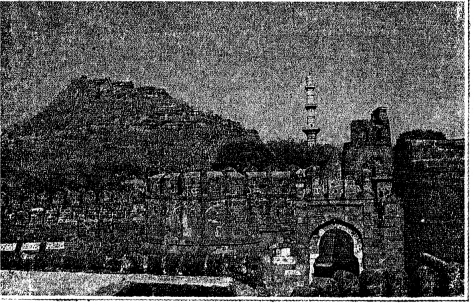
This is a picture of the remains Daulatabad Fort.
Question 1.
Name the ruler who built it.
Answer:
Muhammad-bin-Tughlaq.
Question 2.
Write the two reasons behind the transfer of capital from Delhi to Daulatabad.
Answer:
The transfer of the capital from Delhi to Devagiri (renamed Daulatabad) in the Deccan. Two major reasons prompted the sultan to take the decision.
- Central location: With the expansion of the Delhi Sultanate into the Deccan, Devagiri was centrally located and nearly equidistant from Delhi and other important places.
- Mongol invasions: Repeated Mongol attacks posed a great threat to Delhi. Daulatabad was at a safe distance from the invaders.
Question 3.
What were the results of the transfer of capital?
Answer:
Consequences: In the absence of the sultan, Delhi was now exposed to renewed attacks by the Mongols. Realizing his folly, Muhammad bin Tughlaq shifted his capital back to Delhi after 2 years. The people were ordered to return. The suffering and mental agony caused great resentment. The experiment was a dismal failure. It had drained the treasury and reduced the grand and prosperous capital of Delhi to a mere shadow of its former self. Daulatabad. a monument of misdirected energy, became a deserted city.
I. Time To Do
- Crossword:
Down
- Founder of Slave Dynasty
- Leader of Mongols Across
- Daughter of Iltutmish
- Group of Turkish nobles called
Answer:

Additional Questions
(The Delhi Sultanate)
A. Fill in the blanks:
- The founder of the Khilji dynasty was Jalaluddin – Khilji,
- Alauddin was a brilliant general and a shrewd administrator.
- Alauddin was the first Turkish ruler to build an empire in India.
- Ghiyasuddin Tughlaq was an efficient administrator and a capable military commander.
- Muhammad bin Tughlaq realized the importance of a strong and powerful army to strengthen and secure the position of the ruler. He needed additional revenue to increase military resources.
- Firoze Shah’s economic reforms improved agricultural production and made the peasants prosperous and happy.
- Alauddin built a strong defence system to protect his empire from Mongol raids.
- Iltutmish defeated the Rajput rulers of Ujjain, Ranthambore, Malwa, and Gwalior and brought the whole of North India upto the river Narmada under his control.
- The Caliph of Baghdad recognized Iltutmish as the sovereign of India. He was succeeded by his daughter Razia.
B. Match the following:
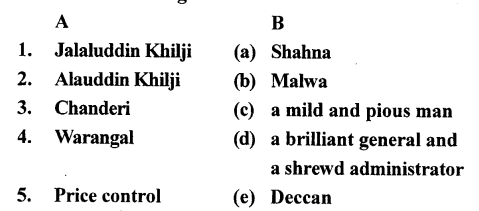
Answer:
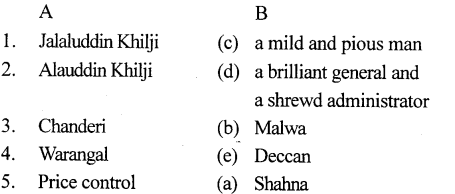
C. State weather the following statements are True Or False:
- Alauddin conquered Chittor, the capital of Mewar/ Malwa/Warangal.
Ans. Alauddin conquered Chittor, the capital of Mewar. - Alauddin was the first Turkish ruler to send an expedition to Gujarat/Rajasthan/the Deccan.
Ans. Alauddin was the first Turkish ruler to send an expedition to the Deccan. - Most historians have traced the failure of Muhammad bin Tughlaq’s schemes to his character/education/ intelligence.
Ans. Most historians have traced the failure of Muhammad bin Tughlaq’s schemes to his character. - Firoze Shah laid out about 1,200 gardens and orchards/ lakes/roads around Delhi
Ans. Firoze Shah laid out about 1,200 gardens and orchards around Delhi. - The final blow to the Delhi Sultanate was dealt by the invasion of Babur/Timur/Khizr Khan.
Ans. The final blow to the Delhi Sultanate was dealt by the invasion of Timur.
D. State whether the following are true or false:
- Alauddin dreamt of conquering the whole world.
True. - Under Alauddin, spies were kept in every unit of the army.
True. - Alauddin’s death was followed by great political turmoil.
True. - Muhammad bin Tughlaq was a diligent ruler who undertook projects that were brilliantly conceived and executed.
False.
Correct: Muhammad bin Tughlaq was a diligent ruler who undertook projects that were brilliantly conceived–and poorly executed. - Muhammad bin Tughlaq’s of increasing the taxes in the Ganga-Yamuna Doab region led to the development of agriculture in that region.
False.
Correct: The policy of increasing the taxes in the Ganga-Yamuna Doab region led to the severe set back of agriculture in that region. - Muhammad bin Tughlaq stayed in Daulatabad for 5 years.
False.
Correct: Muhammad bin Tughlaq stayed in Daulatabad for 2 years.
E. Answer the following questions in one or two words/ sentences:
1. Under what circumstances did Alauddin ascend the throne of Delhi?
Ans. Alauddin captured the throne of Delhi by killing his uncle Jalaluddin Khilji. As the situation at that time was very worse because Jalaluddin was very mild and pious person which led to lawlessness and revolts. Alauddin took advantage of the situation and ascended the throne.
2. How did Alauddin Khilji win over the rebellious nobles after capturing the throne?
Ans. Alauddin Khilji won over the nobles to his side by bribing them with rich gifts.
3. Name the capital of Mewar.
Ans. Chittor the capital of Mewar.
4. What did the Rajput women in the royal palace do when Alauddin Khilji captured Chittor?
Ans. The women performed jauhar and burnt themselves to death.
5. Who led Alauddin’s Deccan campaigns?
Ans. The Deccan expeditions were led by Malik Kafur.
6.Why do modern historians reject the account of a mass exodus from Delhi to Daulatabad?
Ans. Modem historians, however, do not accept the account of a mass exodus. According to them, Delhi was never depopulated because there is evidence to prove that construction work was carried out in Delhi during the period of transfer.
7. Mention any one economic reform introduced in the Doab region by Firozc Shah Tughlaq.
Ans. Land taxes were reduced in the Doab. All loans given during the famine were cancelled. Many taxes were abolished.
8. Give one example to show that Firoze Shah wasconcerned about the welfare of his poor subjects.
Ans. Free hospitals were set up for the poor.
F. Answer the following questions briefly:
Question 1.
With reference to the following conquests, briefly explain how Alauddin extended the boundaries of the – Delhi Sultanate: (a) Conquest of Gujarat (b) Conquest of the Rajput states.
Answer:
(a)
Conquest of Gujarat: Alauddin extended the boundaries of the Delhi Sultanate by sending an expedition to Gujarat which was conquered and annexed.
(b)
Conquest of the Rajput states: Alauddin first captured the fort of Ranthambore and then attacked Chittor, the capital of Mewar. The Rajputs fought bravely but lost the battle. This was followed by the capture of the important cities of Mandu, Ujjain, Dhar and Chanderi in Malwa. By 1305 CE, Alauddin become the master of the whole of North India.
Question 2.
Give an account of Alauddin Khilji’s (a) Deccan conquest and (b) Deccan policy.
Answer:
(a) Deccan conquest: Alauddin was the first Muslim ruler to send an expedition to the Deccan. This expedition was led by Malik Kafur, who defeated the rulers of
Devagiri Warangal and Dwarasamudra and attacked and plundered Madurai in the far South. Thus Alauddin become the first Turkish ruler to extend his influence, south of the Vindhyas.
(b) Deccan policy: Alauddin did not annex the Deccan after conquering it because he realized that it would not be easy to control these provinces from Delhi. Moreover his main objective in conquering it was to acquire as much wealth as possible from the South to pay for the maintenance of his huge army.Alauddin forced the rulers of Deccan to acknowledge his supremacy and pay heavy annual charges as a mark of submission to his over-lordship.
Question 3.
How did Alauddin protect the Delhi Sultanate from repeated Mongol invasions?
Answer:
Alauddin took following steps to protect his empire from the Mongols invasions:
- The forts along the route of Mongols-attacks were repaired and the frontier provinces were placed under the best generals.
- The army was reorganized and strengthened.
- Mongol leaders were captured and trampled under the feet of elephants.
- The Mongols who after embracing Islam settled down in Delhi during Jalaluddin’s reign were mercilessly killed.
Question 4.
Why is Muhammad bin Tughlaq regarded as one of the most accomplished and learned scholars of his times?
Answer:
Muhammad bin Tughlaq is regarded as one of the most accomplished and learned scholars of his times due to his intellectual curiosity and thrust for getting more knowledge. He was gifted with an extraordinary memory. He was a master in logic, philosophy, mathematics, astronomy and physical sciences. He was a lover of Persian literature and poetry, calligraphy, fine arts and music. He loved the company of learned men.
Question 5.
Discuss the causes and results of the taxation scheme of Muhammad bin Tughlaq in the Doab.
Answer:
Muhammad bin Tughlaq realized the importance of a strong and powerful army to strengthen and secure the position of the ruler. To increase military resources, he needed additional revenue. The Ganga-Yamuna Doab (the area between) the Ganga and the Yamuna rivers) was a fertile region. The land tax in this area was increased. Unfortunately, the rains failed and a severe famine broke out. People refused to pay the 1 enhanced taxes. But the tax collectors showed no mercy and continued to collect the taxes with such rigour that the peasants were ruined. To escape the tyranny of the tax collectors, the peasants abandoned their lands and fled to the jungles.
Question 6.
Why was the capital transferred from Delhi to Daulatabad? Explain the consequences of this project.
Answer:
The transfer of the capital from Delhi to Devagiri (renamed Daulatabad) in the Deccan. Two major reasons prompted the sultan to take the decision.
- Central location: With the expansion of the Delhi Sultanate into the Deccan, Devagiri was centrally located and nearly equidistant from Delhi and other important places.
- Mongol invasions: Repeated Mongol attacks posed a great threat to Delhi. Daulatabad was at a safe distance from the invaders.
- Consequences: In the absence of the sultan, Delhi was now exposed to renewed attacks by the Mongols. Realizing his folly, Muhammad bin Tughlaq shifted his capital back to Delhi after 2 years. The people were ordered to return. The suffering and mental agony caused great resentment. The experiment was a dismal failure. It had drained the treasury and reduced the grand and prosperous capital of Delhi to a mere shadow of its former self. Daulatabad, a monument of misdirected energy, became a deserted city.
Question 7.
What arrangements did Muhammad bin Tughlaq make to achieve his ambition of a world empire? Why did his scheme fail?
Answer:
Muhammad bin Tughlaq dreamt of establishing a world empire. For this he decided to conquer Khurasan, Persia and Iraq. He mobilized a huge army for it and equipped it and paid one full year’s salary in advance. But later he realized that it was not easy to send such a large army across the snowy Himalayan passes. So this scheme failed and it even drained the wealth of the Royal treasury.
Question 8.
What was the condition of the Delhi Sultanate at the end of Muhammad bin Tughlaq’s reign?
Answer:
The condition of the Delhi Sultanate was in a state of decay and disintegration after twenty five year of reign of Muhammad bin Tughlaq.
Question 9.
To what would you attribute the failure of Muhammad bin Tughlaq’s schemes – personal character or prevailing conditions? Give reasons for your answer.
Answer:
Both personal character and prevailing conditions were responsible for the failure of Muhammad bin Tughlaq. In personal side he lacked practical sense and was not able to predict things whereas on other side, conditions prevailing were also not favourable. People were backward and did not respond to new ideas and radical reforms.
Question 10.
What evidence do we have to prove that Alauddin was a patron of art and learning?
Answer:
Alauddin was a patron of art and learning which can be seen clear from the large and beautiful monuments built during his reign. There were many learned scholars and poet in his court, Amir Khusrau, the famous Persian poet was one of them. The Alai Darwaza is one of the most beautiful architecture of that time. He also built many beautiful palaces and mosques. The Siri Fort and the Palace of Thousand Pillars are good examples of it.
G Picture study:
This is a picture of the most beautiful specimen of Khilji architecture, which was added as an entrance to the Qutb complex in Delhi.
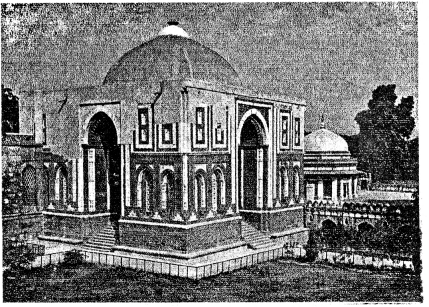
Question 1.
Identify the monument.
Answer:
Alai Darwaja.
Question 2.
During whose reign was it built?
Answer:
Alauddin Khilji.
Question 3.
With reference to the reign of this ruler, mention two important features of each of the following:
(a) Reorganization of the army
(b) Revenue reforms
(c) Market control policy
Answer:
(a)
Alauddin was the first Sultan of Delhi to lay the foundation of a permanent standing army. The size of the standing army was greatly enlarged. Alauddin introduced the system of branding horses and maintaining a descriptive roll of the soldiers. Spies were kept in every unit of the army.
(b)
Alauddin introduced certain revenue reforms. The land was measured and the share of the state was fixed. Special revenue officials were appointed to collect the taxes.
(c)
Alauddin set up three markets at Delhi – one for food grains, the second for cloth and the third for horses, slaves and cattle. Each market was under the control of an officer called Shahna.
- The prices of all commodities were fixed and prices of essential items were kept low.
- Market officers were appointed to keep a strict watch on the prices, weights and the activities of the traders.
- Anyone caught hoarding goods or cheating customers in price or weight was severely punished.
- State warehouses were set up and stocked with food grains.